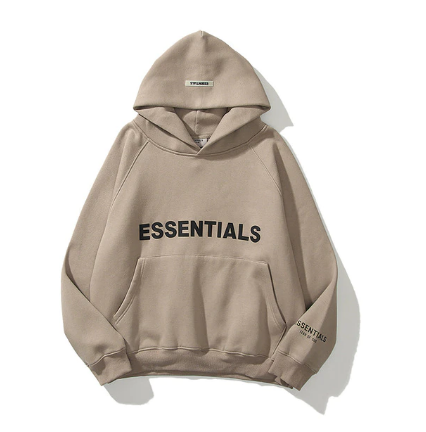The Hoodie: From Humble Beginnings to Fashion Staple
The hoodie, Essential Hoodie a simple, utilitarian garment, has undergone a remarkable transformation, evolving into a versatile and iconic fashion staple. Its journey from a humble workwear item to a symbol of youth culture and streetwear is a testament to its enduring appeal and adaptability.
Early Origins: A Garment for Workers
The hoodie’s roots can be traced back to the early 20th century, when it emerged as a practical garment for workers in cold climates. Its hooded design provided protection from the elements, while its loose-fitting silhouette allowed for easy movement. Initially, hoodies were primarily made of heavy-duty fabrics like cotton or wool, designed to withstand harsh conditions.
The Rise of Youth Culture
In the mid-20th century, the hoodie began to gain popularity among young people, particularly in the United States. Its association with athletic wear and casual comfort made it a popular choice for leisure activities. As youth culture began to assert itself, the hoodie became a symbol of rebellion and nonconformity.
The 1980s and Beyond: A Cultural Icon
The 1980s marked a significant turning point for the hoodie, as it became a cultural icon. Hip-hop and streetwear culture embraced the hoodie as a versatile and affordable fashion item. Iconic brands like Champion and Nike began to produce hoodies in a variety of styles and colors, catering to the growing demand.
The Evolution of Design
Over the years, the hoodie has undergone a series of design innovations. Initially, hoodies were characterized by their simple, utilitarian aesthetic. However, as designers sought to differentiate themselves, they began to experiment with new materials, patterns, and silhouettes.
- Materials: Modern hoodies are made from a wide range of fabrics, including fleece, cotton, and synthetic blends. Some hoodies feature luxurious materials like cashmere or silk, while others are made from sustainable or recycled fabrics.
- Patterns: From classic solid colors to bold graphic prints, hoodies have become a canvas for creative expression. Designers often collaborate with artists and brands to create unique and eye-catching patterns.
- Silhouettes: The traditional hoodie silhouette has evolved to include a variety of options, such as slim-fit, oversized, and cropped styles. Some hoodies feature unique details like kangaroo pockets, drawstrings, and contrasting panels.
Versatility and Style
The hoodie’s enduring appeal lies in its versatility. It can be dressed up or down to suit a variety of occasions. Paired with jeans and sneakers, a hoodie can create a casual and comfortable look. When combined with tailored trousers and a blazer, it can add a touch of modern edge to a more formal outfit.
The Hoodie’s Enduring Appeal
The hoodie’s journey from humble Essentials Tracksuit to fashion staple is a testament to its enduring appeal and adaptability. Its ability to blend seamlessly with different styles and cultures has made it a timeless piece of clothing. As designers continue to push the boundaries of hoodie design, it is clear that this versatile garment will remain a staple in wardrobes around the world for years to come. Early Origins: A Garment for Workers
The hoodie’s roots can be traced back to the early 20th century, when it emerged as a practical garment for workers in cold climates. Its hooded design provided protection from the elements, while its loose-fitting silhouette allowed for easy movement. Initially, hoodies were primarily made of heavy-duty fabrics like cotton or wool, designed to withstand harsh conditions.
The Rise of Youth Culture
In the mid-20th century, the hoodie began to gain popularity among young people, particularly in the United States. Its association with athletic wear and casual comfort made it a popular choice for leisure activities. As youth culture began to assert itself, the hoodie became a symbol of rebellion and nonconformity.
The 1980s and Beyond: A Cultural Icon
The 1980s marked a significant turning point for the hoodie, as it became a cultural icon. Hip-hop and streetwear culture embraced the hoodie as a versatile and affordable fashion item. Iconic brands like Champion and Nike began to produce hoodies in a variety of styles and colors, catering to the growing demand.
The Evolution of Design
Over the years, the hoodie has undergone a series of design innovations. Initially, hoodies were characterized by their simple, utilitarian aesthetic. However, as designers sought to differentiate themselves, they began to experiment with new materials, patterns, and silhouettes.
- Materials: Modern hoodies are made from a wide range of fabrics, including fleece, cotton, and synthetic blends. Some hoodies feature luxurious materials like cashmere or silk, while others are made from sustainable or recycled fabrics.
- Patterns: From classic solid colors to bold graphic prints, hoodies have become a canvas for creative expression. Designers often collaborate with artists and brands to create unique and eye-catching patterns.
- Silhouettes: The traditional hoodie silhouette has evolved to include a variety of options, such as slim-fit, oversized, and cropped styles. Some hoodies feature unique details like kangaroo pockets, drawstrings, and contrasting panels.
Versatility and Style
The hoodie’s enduring appeal lies in its versatility. It can be dressed up or down to suit a variety of occasions. Paired with jeans and sneakers, a hoodie can



